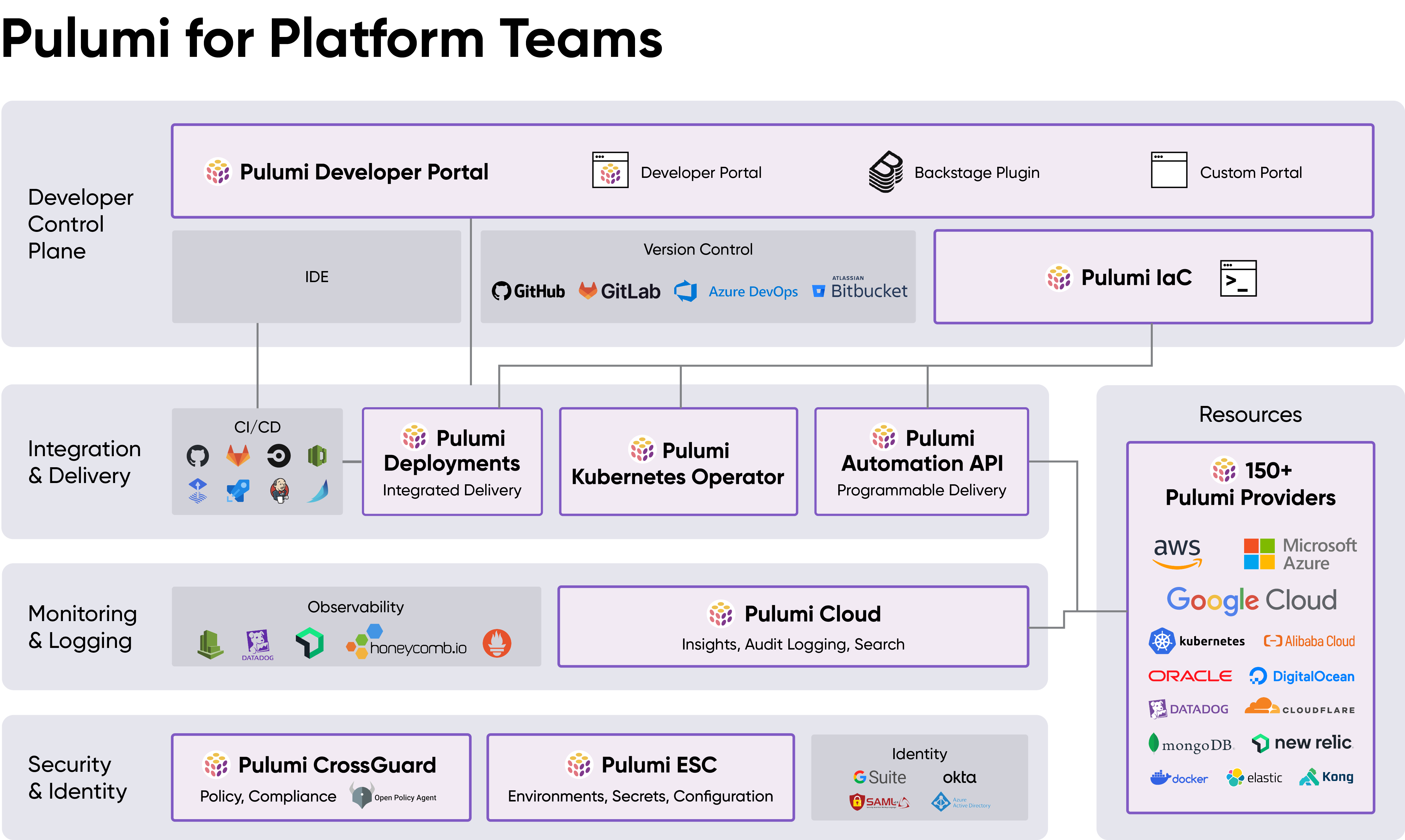Internal developer platform-in-a-box
Challenges of platform teams

Developer speed
Remove productivity obstacles like configuring cloud architectures, provisioning bottlenecks, and testing and deployment.

Security and compliance
Set up guardrails that enforce compliance and standards while maintaining visibility over what’s being deployed and how.

Balancing agility and guardrails
Accomplishing both speed and compliance with limited resources and without stifling developers’ autonomy and flow.
How Pulumi’s platform-in-a-box can help
Internal developer portals (IDPs) enable developers to quickly provision approved infrastructure, boosting productivity with pre-configured architectures, automated testing, and deployment adhering to organizational standards.
Boost developer productivity
Help your developers ship faster by abstracting the complexities of configuring, testing, and deploying infrastructure. Provide self-serve infrastructure and eliminate bottlenecks on platform teams.
Enforce standards and compliance
Make sure infrastructure is standardized and follows company standards and compliance. Distribute approved templates and enforce processes for testing and deployment.
Increase visibility and observability
Always know what infrastructure is running and where so you can monitor costs, identify security risks, update software, and more.
IDP solutions out-of-the-box
Use Pulumi building blocks to build every layer of your IDP. Building blocks are composable and programmable via rich APIs, with open source and SaaS options available.
Collaborate across DevSecOps
Pulumi’s infrastructure and policy as code engine fosters collaboration between developers, security, and operations through common, popular programming languages.
Case Studies
Atlassian Bitbucket reduced developers’ time spent on maintenance by 50% with a self-service platform built with Pulumi.
Washington Trust Bank maintains compliant and secure infrastructure deployments with policy packs and policy enforcement.
Mercedes-Benz enabled developers to provision Azure Kubernetes environments with a self-service platform built with Pulumi.

How Pulumi for Platform Teams works
Pulumi offers all the building blocks needed to build internal developer portals (IDPs). Use them together as a complete IDP solution or integrate components selectively into your existing IDP via rich APIs.

Developer control
Define standard infrastructure as code templates in your preferred programming language with Pulumi, allowing developers in your organization to self-service infrastructure. Make self-service provisioning easy for developers with Pulumi’s out-of-the-box portal or integrate your Backstage portal.
Pulumi IaC
Utilize open-source IaC in TypeScript/JavaScript, Python, Go, C#, Java, and YAML. Build and distribute reusable infrastructure components for 150+ cloud & SaaS providers, supporting modern and cloud-native architectures.
Pulumi Developer Portal
Distribute standard private templates through an out-of-the-box Service Catalog experience, which developers can browse and deploy from using the Pulumi Cloud console. API integration with your VCS, Pulumi Deployments, CI/CD, and more.
Backstage Plugin
Enable developers to browse, deploy, and monitor Pulumi infrastructure deployments from an existing Backstage portal. Use the plugin to integrate Backstage with Pulumi Developer Portal, where your private infrastructure templates are hosted.
Pulumi Deployments
Centrally orchestrate automated deployment workflows with `git push to deploy`, UI triggers, and API. Advanced capabilities like ephemeral environments and extensibility for drift detection, TTL, blue/green, and more. Integrate with CI/CD, VCS, and more using the API. SaaS or self-hosted runners available.
Pulumi Automation API
Build custom deployment and CI/CD workflows that integrate with Pulumi Developer Portal and custom portals or CLIs. Automation API is a programmatic interface for Pulumi CLI, allowing you to embed infrastructure automation into application code that runs on your servers.
Integration & delivery
After setting up your portal and templates, automate a standardized deployment process by integrating your existing CI/CD tools. Use Pulumi Deployments for managed deployments with advanced capabilities and integrations. For more control, opt for Pulumi Automation API to program and operate self-hosted deployments.
Security, monitoring, and logging
Secure, monitor, and log infrastructure deployed by your IDP. Set up deployment guardrails that enforce compliance. Receive detailed history, tracking, and audit logs for infrastructure. Manage configurations and secrets centrally and securely, ensuring you have visibility and control over who can access secrets and configuration.
Pulumi CrossGuard
Enforce policies across your organization. Utilize compliance-ready policies for any cloud to enhance compliance and use remediation policies to automatically correct configuration violations like auto-tagging, removing Internet access, and enabling storage encryption.
Pulumi Cloud
Maintain control and tracking over deployed infrastructure, with complete history of updates and audit logs easily viewable from a console. Enhance security with RBAC, identity provider integrations, SSO, and more.
Pulumi ESC
Centrally store and manage secrets and configuration from different providers. It provides a unified, secure location for all your configuration while managing developer access centrally.
Onboarding help is available
Platform assessment
We have architects available to assist you with free assessments and recommendations.
Platform workshops
Our engineers present workshops that teach you how to use Pulumi and IaC to accomplish your IDP goals.
Template building
Get help from our experts on building internal infrastructure templates for any cloud and any programming language.
Migration services
We can help you migrate from your existing Terraform or IaC tool and offer solutions for hybrid IaC scenarios.
Talk to an architect
Ready to build your IDP with Pulumi? Our architects are available to provide a free consultation and recommendations on how to get started.